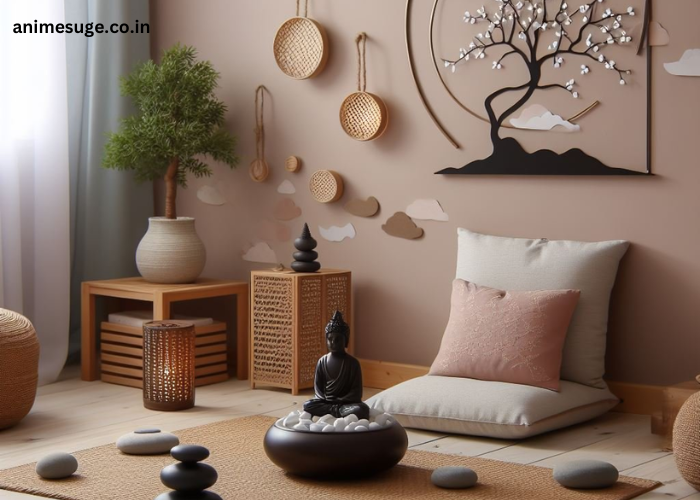In today’s fast-paced world, finding moments of peace and serenity can often feel like a challenge. However, the concept of “Home Zen” offers a solution, creating spaces that are not just places to live, but sanctuaries for relaxation and mindfulness. By blending minimalism, nature, and mindful design, you can transform your home into a tranquil haven that supports your well-being. Let’s explore the essentials of creating a Zen-inspired home.
What is Home Zen?
Home Zen is the art of curating a space that promotes peace, balance, and tranquility. Rooted in the principles of Zen Buddhism, which emphasizes meditation, simplicity, and harmony with nature, Home Zen is about creating an environment that fosters mindfulness and mental clarity. It’s a sanctuary where each room invites calm and every design choice enhances a sense of well-being.
1. Embrace Minimalism: Less is More
The first step in creating a Zen-inspired home is to embrace minimalism. Clutter is the enemy of calm, and a minimalist approach helps eliminate distractions, allowing the mind to rest. Start by decluttering your space. Donate or sell items you no longer need, and focus on keeping only those that serve a purpose or bring joy.
Opt for simple furniture with clean lines and neutral colors. Less ornamentation and fewer distractions will help your space feel more serene. This doesn’t mean your home should feel barren; rather, it should feature thoughtfully chosen, high-quality items that promote relaxation.
2. Bring Nature Indoors: The Power of Natural Elements
In Zen design, nature plays a crucial role in creating a peaceful atmosphere. Bringing natural elements into your home is an effective way to infuse your space with tranquility. Incorporate indoor plants, such as bamboo, succulents, or peace lilies, which purify the air and contribute to the feeling of calm.
Natural materials like wood, stone, and bamboo can be incorporated into furniture, flooring, and decor to create a harmonious connection between the indoors and the natural world outside. You might also consider adding natural light, which can lift your mood and promote a sense of spaciousness.
3. The Art of Simplified Color Palettes
The colors you choose for your home are integral to the Zen ambiance. Soft, neutral shades such as whites, beiges, grays, and muted greens are ideal, as they help calm the senses and provide a soothing backdrop for relaxation. These hues also work well with natural materials, contributing to a sense of cohesion.
While neutral tones dominate a Zen-inspired space, you can accentuate the atmosphere with pops of natural colors. For example, soft greens from plants, warm browns from wood furniture, and tranquil blues from decorative elements can enhance the feeling of serenity.
4. Create Spaces for Mindfulness and Meditation
Zen spaces are all about fostering mindfulness and presence. Dedicate a quiet corner or a small room to meditation or yoga. A comfortable cushion or mat, soft lighting, and minimal distractions will allow you to engage in moments of reflection and inner peace.
Consider including items that enhance the meditation experience, such as candles, incense, or small water features. These elements are known for their calming properties, contributing to a space where the mind can unwind.
5. Focus on Sensory Harmony: Sound, Smell, and Touch
Zen design extends beyond visual aesthetics. To create a truly tranquil home, consider the other senses as well:
- Sound: Soft, calming sounds can elevate the peaceful atmosphere. Incorporate gentle background music, wind chimes, or even a small indoor water fountain that produces a soothing, flowing sound.
- Smell: Aromatherapy is a key component of Zen. Essential oils such as lavender, sandalwood, and eucalyptus can be diffused throughout your space to promote relaxation and mental clarity. You could also introduce incense or scented candles with natural fragrances.
- Touch: Textures play a significant role in creating a calming environment. Incorporate soft textiles like cotton, linen, or wool in your furniture and decor. Fuzzy throws, plush pillows, and natural rugs invite tactile experiences that contribute to overall comfort.
6. Mindful Organization: A Place for Everything
Organization is central to the Zen philosophy of order and clarity. Everything in a Zen home should have its place, making it easy to maintain a clutter-free environment. Organize your home with intention, and use storage solutions that are both functional and aesthetically pleasing.
Consider open shelving with neatly arranged books and items, or closed storage to keep your space looking streamlined and serene. The key is to create an environment where everything is in harmony, and no item feels out of place.
7. Lighting: The Right Ambiance
Lighting plays a pivotal role in creating the right mood for a Zen-inspired home. Avoid harsh, fluorescent lighting, and instead opt for soft, warm lights that create a relaxing ambiance.
Use dimmable lights to control the atmosphere based on the time of day and your needs. Lamps with natural materials like wood or stone can enhance the calming feel. Consider adding candles for a warm, flickering light that invites relaxation in the evening.
Conclusion
Transforming your home into a Zen haven is an ongoing process that requires mindful choices in design, decoration, and daily habits. By focusing on simplicity, natural elements, and sensory harmony, you can create a space that nourishes your body, mind, and spirit. Home Zen isn’t just about aesthetics—it’s a way of being, fostering peace and presence in your life. With careful attention to your space, you can cultivate a home that becomes your personal sanctuary, offering solace and tranquility whenever you need it.
